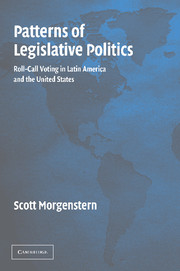Book contents
- Frontmatter
- Contents
- Tables and Figures
- Preface and Acknowledgments
- Party, Faction, and Coalition Names and Abbreviations
- 1 Patterns of Legislative Politics: Identifiability and Flexibility
- 2 Representation and the Agent System
- 3 Identifying Agents
- 4 Influences on Agent Unity: Discipline and Cohesion
- 5 Explaining Voting Unity
- 6 Policy Coalitions and Agent Flexibility
- 7 Conclusion
- Bibliography
- Subject Index
- Author Index
4 - Influences on Agent Unity: Discipline and Cohesion
Published online by Cambridge University Press: 24 July 2009
- Frontmatter
- Contents
- Tables and Figures
- Preface and Acknowledgments
- Party, Faction, and Coalition Names and Abbreviations
- 1 Patterns of Legislative Politics: Identifiability and Flexibility
- 2 Representation and the Agent System
- 3 Identifying Agents
- 4 Influences on Agent Unity: Discipline and Cohesion
- 5 Explaining Voting Unity
- 6 Policy Coalitions and Agent Flexibility
- 7 Conclusion
- Bibliography
- Subject Index
- Author Index
Summary
The previous chapters have challenged the notion of parties as necessarily unitary and rational actors and turned our attention to other legislative agents. Chapter 3 argued that the ballot structure provides a succinct explanation for whether parties, factions, or coalitions will gain prominence in the political dialogue of a country. It also showed, however, that the level of voting unity of these agents varies greatly. This chapter seeks a theoretical understanding of this variation.
Following Özbudun (1970), agent unity can result from two broad factors: cohesion and discipline. A group of legislators are cohesive when they vote together as a result of shared goals or common beliefs; discipline yields voting unity as the result of influential leaders (see also Ranney and Kendall, 1956). Thus, two interrelated and complementary – not competing – sets of variables contribute to an agent's unity. The first set, pertaining to cohesion, includes those that measure the extent to which an agent's legislators share ideological or electoral affinities. When groups lack ideological fervor or common interests, voting unity requires strong leaders who can impose discipline.
As unity levels vary both across and within countries, the variables that determine the phenomenon can be analytically subdivided according to whether their primary effect is on inter- or on intracountry variation. By and large, the factors determining the level of cohesion among a group's members are particular to the group and thus explain the different unity rates of agents within a country.
- Type
- Chapter
- Information
- Patterns of Legislative PoliticsRoll-Call Voting in Latin America and the United States, pp. 85 - 114Publisher: Cambridge University PressPrint publication year: 2003



